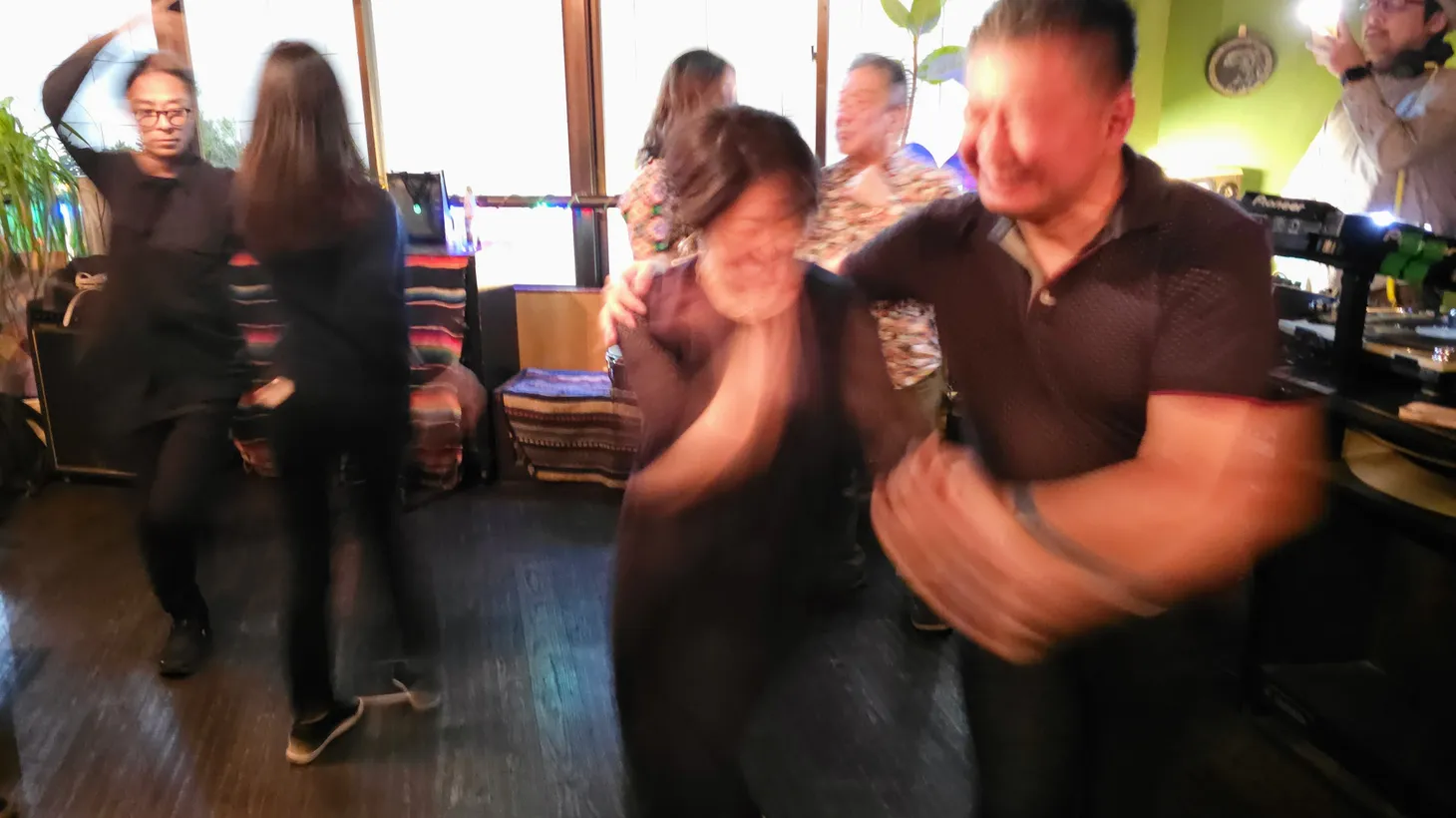People dance salsa, son cubano, and cumbia at the Mucho Mucho Mambo party in Tokyo, Japan, on March 28, 2025. Photo credit: Rodrigo Cervantes.
For more than 20 years, Masaki Narahara, a.k.a. DJ Masaki69, has played at music parties and bars around Tokyo. His vinyl collection – which he says includes more than 4,000 records – is heavy on classic tropical hits from Latin America and includes oddities like vinyls from Ricky Martin’s former boy band.
“Do you know Menudo?” he asks as he chuckles, “I have a lot of Menudo records. I don’t know why I keep them!” 
DJ Masaki69 (Masaki Narahara) is a music collector and DJ from Tokyo. Photo credit: Rodrigo Cervantes.
Masaki is part of an underground movement that has been taking over some bars and live music venues across Japan, in which old school salsa and son, or new Latin hip-hop and cumbia, are finding appreciative Japanese audiences.
Local and international musicians play at Japan Cumbia Festival in Shinjuku, Tokyo, on December 15, 2024. Photo credit: Rodrigo Cervantes.
The love for Latin music in Japan comes from the Golden Age of Tropical Music in the mid-20th century, Masaki explains. He says he heard Latin music for the first time from his father.
“After World War II, in the 1950s and 1960s, Latin music was very popular in Japan. My father had the Pérez Prado and Tito Puente vinyl records,” he recalls.
Mexican trio Los Panchos was noticeably popular in Japan back then, while local artists played and sang mambo, chachachá, and bolero with a Japanese touch. One of the most popular singers at the time, Chiemi Eri, covered tropical songs that were already popular in English or Spanish, such as “Papa Wa Mambo Ga Osuki” (Perry Como’s “Papa Loves Mambo”).
Masaki says some Japanese connect with these rhythms partly because they help them forget stress and their culture’s strict social rules.
“Japanese people are always thinking about what other Japanese people think,” he says. “Japanese people cannot behave like Latino people. They want to, but they are a little bit shy and hide.”
DJ Pancho is part of the Latin music scene in Tokyo and Kanagawa. Photo credit: Rodrigo Cervantes.
DJ Pancho usually spins Latin music in Kanagawa, on the outskirts of Tokyo, where he says there’s “mucho barrio.” He’s half Dominican, half Japanese, but his style and looks could be 100% from East Los Angeles: baggy Dickies pants, flat brim cap, tattoos, and sunglasses. Then there’s his music taste, in which cumbia prevails: Los Ángeles Azules, Grupo 5, and Selena.
Shin Miyata, who went to East LA College four decades ago to do Chicano Studies and now runs a record label and Chicano parties in Tokyo, says there’s a distinction between Japanese following traditional Latin music and those who pursue the Chicano style and fashion.
“People took ideas through the hip-hop movies and videos in the 90s, or from the 60s, from Pachuco to the Chicano soul,” he says, “so sometimes it’s different here, the cumbia market with the Chicano soul people.”
DJ Mikistyle stands outside La Puerta in Osaka, a shop specializing in Chicano clothes and products. Many Japanese in Osaka have adopted this style. Photo credit: Rodrigo Cervantes.
Miyata says Mexican American, Chicano, and cholo styles arrived to Japan in the early 90s through movies like Blood In Blood Out and hip-hop bands like Cypress Hill.
Shin Miyata went to LA to learn about Chicano culture four decades ago. Photo credit: Rodrigo Cervantes.
“There’s always been common things between Japanese and the Mexicanos?” Miyata says.
He cites a shared sense of family and romanticism, but says he would like Japanese people to learn more about the social, political struggles of the Chicanos rather than just liking the looks and music.
“We, the Japanese, always pick up the surface, but I want people to go more into the deep side,” he says.
Ayumi Nobe, a.k.a. DJ Pope, has toured Latin America and California, and says there are more and more local Japanese musicians playing their own take on Latin music. 
DJ Pope spins vintage and electro cumbia in a bar in Shibuya, Tokyo, on January 19, 2025. Photo credit: Rodrigo Cervantes.
Among those artists are Los Tequila Cokes, Rojo Regalo, Mumbia y sus Candelosos, Mochilero, and the internationally acclaimed band Minyō Crusaders, which appear in the recently launched documentary Bring Minyō Back!
“Minyō Crusaders combine minyō, a very traditional music style from Japan, with Latin music. It’s really original,” Pope says.
The band Mumbia y Los Candelosos play in a live house bar in Daikanyamacho, Tokyo, on April 11, 2025. Photo credit: Rodrigo Cervantes.
Pope says the Latin music community in Japan may not be too big, but it’s unique and welcoming.
“So if you have a chance to come to Japan, we can share with you, and maybe we can party with you!” Pope says.
Listen to some artists who’ve given Japanese music a Latin flavor here: 
Dj Beto from California plays his selection of rare and cool tropical beats as a guest in a party in Tokyo on April 11, 2025. Photo credit: Rodrigo Cervantes.
Hey! Did you enjoy this piece? We can’t do it without you. We are member-supported, so your donation is critical to KCRW’s music programming, news reporting, and cultural coverage. Help support the DJs, journalists, and staff of the station you love.
Here’s how:
More from KCRW Features
Latest
Featured
The best of what to see, hear, eat, do, and more.
Donate by midnight tomorrow and your $100 becomes $200 for KCRW, thanks to a $10,000 match by music legend Moby.
DOuble dollars
Get the latest from KCRW in your inbox 3x a week.
Cumbia, salsa, Chicano rap find an underground home in Japan – KCRW
RELATED ARTICLES
